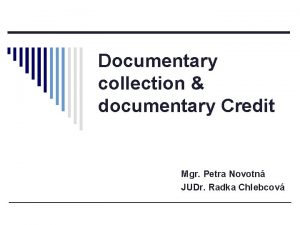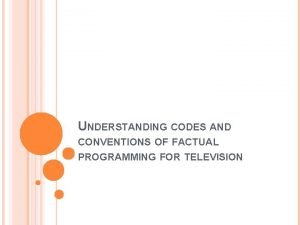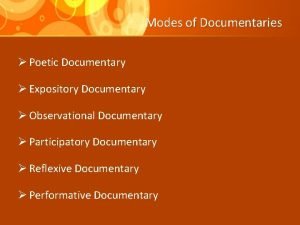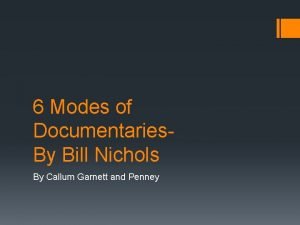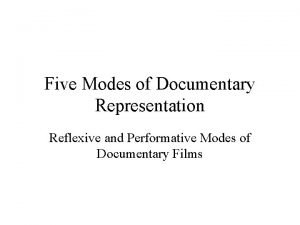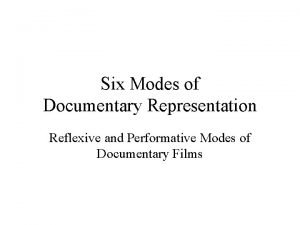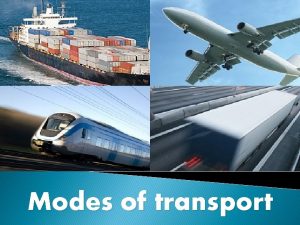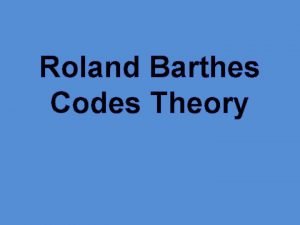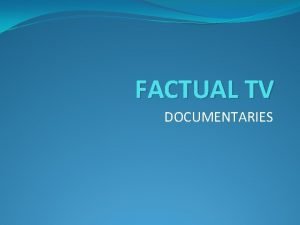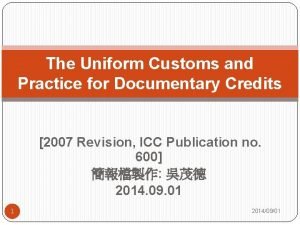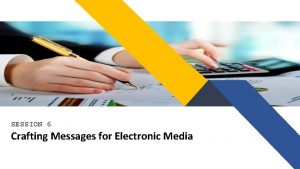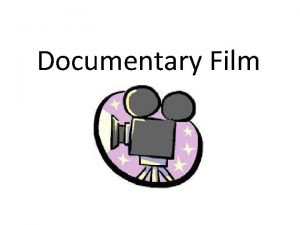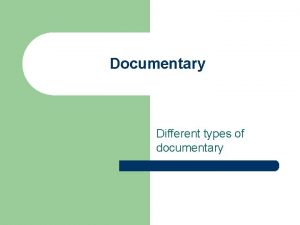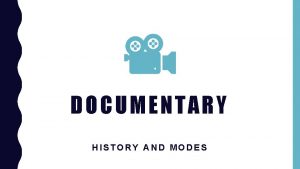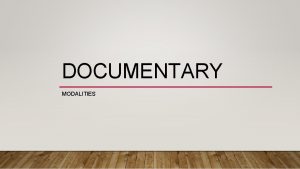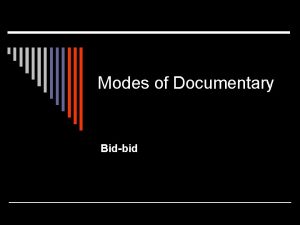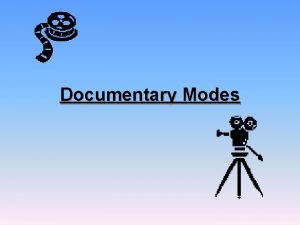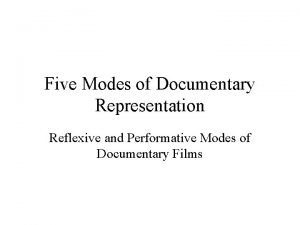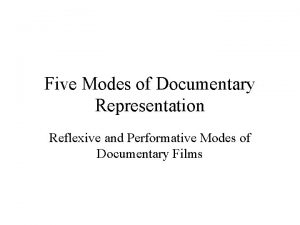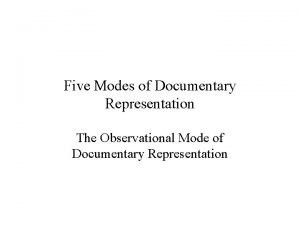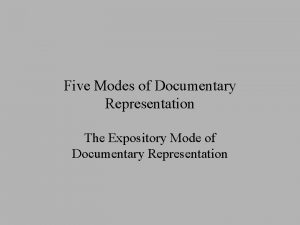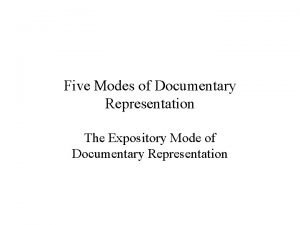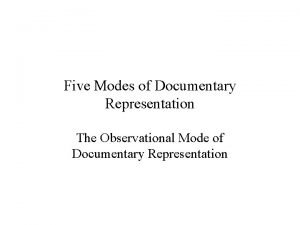THE FIVE MODES OF DOCUMENTARY THE CODES AND
















- Slides: 16

THE FIVE MODES OF DOCUMENTARY & THE CODES AND CONVENTIONS

FIVE MODES OF DOCUMENTARY

Identifying modes of documentary is a way of putting the different types of documentary into categories and is very similar to the genre categories in films. There are overlaps in the different modes and documentaries will often feature conventions from more than one mode.

EXPOSITORY ◦ Voiceover addresses the audience directly ◦ The voiceover may be a ‘voice of God’ commentator (heard but not seen) or ‘voice of authority’ (seen and heard) ◦ Images are used to illustrate the voiceover ◦ Editing is used for continuity, to link together images which support the argument put forward in the voiceover ◦ Assembles a variety of footage, interviews, archive material to support the argument ◦ Attempts to persuade the audience of a particular point of view, often by appealing to logic and the idea of a common sense response.

OBSERVATIONAL MODE ◦ Location shooting- handheld cameras. ◦ Long takes dominate ◦ Synchronous (direct) sound recording ◦ No voiceover (in its purest form) ◦ No interviews ◦ Documentary makers presence is hidden ◦ Subjects pretend they are not being filmed.

PARTICIPATORY/INTERACTIVE ◦ Documentary maker (and crew) interact with subject ◦ Interviews dominate but tend to be formal- literally ‘on the run’ questioning ◦ Use of archive material- stills, news; footage, newspaper headlines, letters etc ◦ Location shooting- handheld camera ◦ Long takes dominate ◦ Synchronous (direct) sound recording ◦ Voiceover- usually by the documentary maker ◦ Documentary maker is visible to the audience- Intervenes and participates in the action.

REFLEXIVE ◦ Borrows techniques from fiction film for an emotional, subjective response ◦ Emphasises the expressive nature of film, anti realist techniques e. g, re enactments, expressive lighting, dramatic music ◦ Voiceover (When present) is likely to be questioning and uncertain – rather than authoritative ◦ Reliance on suggestion rather than fact

PERFORMATIVE ◦ Documentary maker (and crew) interacts with subject. ◦ Documentary maker comments on the process of making the documentary. ◦ The documentary is often shaped in to the narrative of an investigation or searchwhich their may be no satisfactory conclusion to. ◦ Addresses the audience in an emotional and direct way. ◦ Subject matter often to do with identity (gender, sexuality)- rather than ‘factual’ subjects.

CODES AND CONVENTIONS

STUDIO NEWS READERS These are the main reporters or presenters that appear in the broadcasted TV news. They’re the ones that are inside a studio reporting the events that have happened. But what do they do?

WHAT DO STUDIO NEWS READERS DO? - Conduct in depth research, identify & develop news stories of interest. - Edit copy from other reporters or external news agencies. - Write news bulletins, links and assist in the production of scripts. - Research & conduct interview’s in the studio or on location - Provide briefings to crew and contributors

WHAT PERSONAL & PROFESSIONAL SKILLS DO THEY HAVE? Editorial Knowledge Understand legal & ethical issues which affect journalism Good Interpersonal Skills Good Communication Skills

VISUAL CODES Neat haircut; out of his face, not distracting Clean shaven; he doesn’t look rugged Dress; professional, conservative, smart and respectable. It’s serious

CONTRIBUTORS What kinds of contributors would you expect to see on a news programme? - Experts - Witnesses - Members of the public

THE REPORT STRUCTURE Reports are normally comprised of the same techniques: - PTC: Piece To Camera - C/A: Cut Aways - V/O: Voice Over - I/V: Interview - Vox Pops: Voice of the People - Graphics

A TYPICAL STORY STRUCTURE
 Documentary payment
Documentary payment Documentary collection vs documentary credit
Documentary collection vs documentary credit Documentary codes and conventions
Documentary codes and conventions Michael gomersall
Michael gomersall Expository mode documentary
Expository mode documentary Modes of documentary
Modes of documentary Reflexive documentaries
Reflexive documentaries Reflexive documentary
Reflexive documentary Mode of transport
Mode of transport Hermeneutic code meaning
Hermeneutic code meaning 5 elements and 5 senses
5 elements and 5 senses Five years have past five summers with the length
Five years have past five summers with the length One in five challenge
One in five challenge The devil damn thee black
The devil damn thee black Documentary examples
Documentary examples The uniform customs and practice for documentary credits
The uniform customs and practice for documentary credits Compositional mode of social media
Compositional mode of social media

